Pressure Points: Tuck Gets By With Help From His Friends

There’s been a lot of discussion in New York this week about what the Giants will do with veteran defensive end Justin Tuck when he becomes a free agent this offseason in light of his four-sack performance against Washington on Monday night.
Just a guess, but that game won’t really change anything: it was about the easiest four-sack game you will ever see.
There’s no question Tuck was extremely productive getting those four sacks, which were the most for a Giant since Osi Umenyiora set the single-game record of six against the Eagles in 2007. The ninth-year defensive end was named NFC Defensive Player of the Week (whatever that means—no one knows how those awards are even determined), and Tuck even took The MMQB's Edge Rusher of Week 13 honors because of those four sacks. But it wasn’t in a rout, because our Pressure Points were specifically created to take the luster off sacks and put the onus on total pressure. Trent Cole of the Eagles finished just a half-point behind Tuck with half as many sacks.
And Tuck’s four-sack performance wasn’t an individual tour de force. You could say it was an example of great team defense by the Giants, because Tuck wouldn’t have gotten three of his sacks without a lot of help from his friends. A look inside the sacks:
Pressure Points: Tuck Gets By With Help From His Friends
tuck1-1.jpg
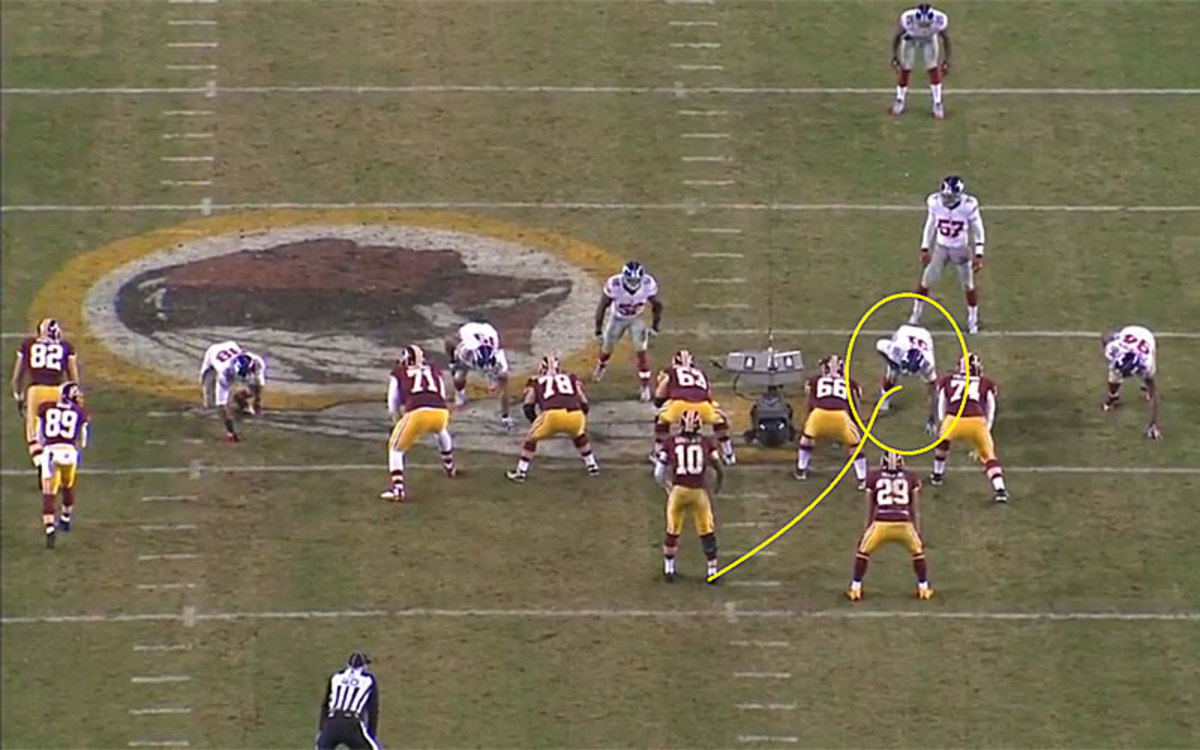
tuck1-2.jpg
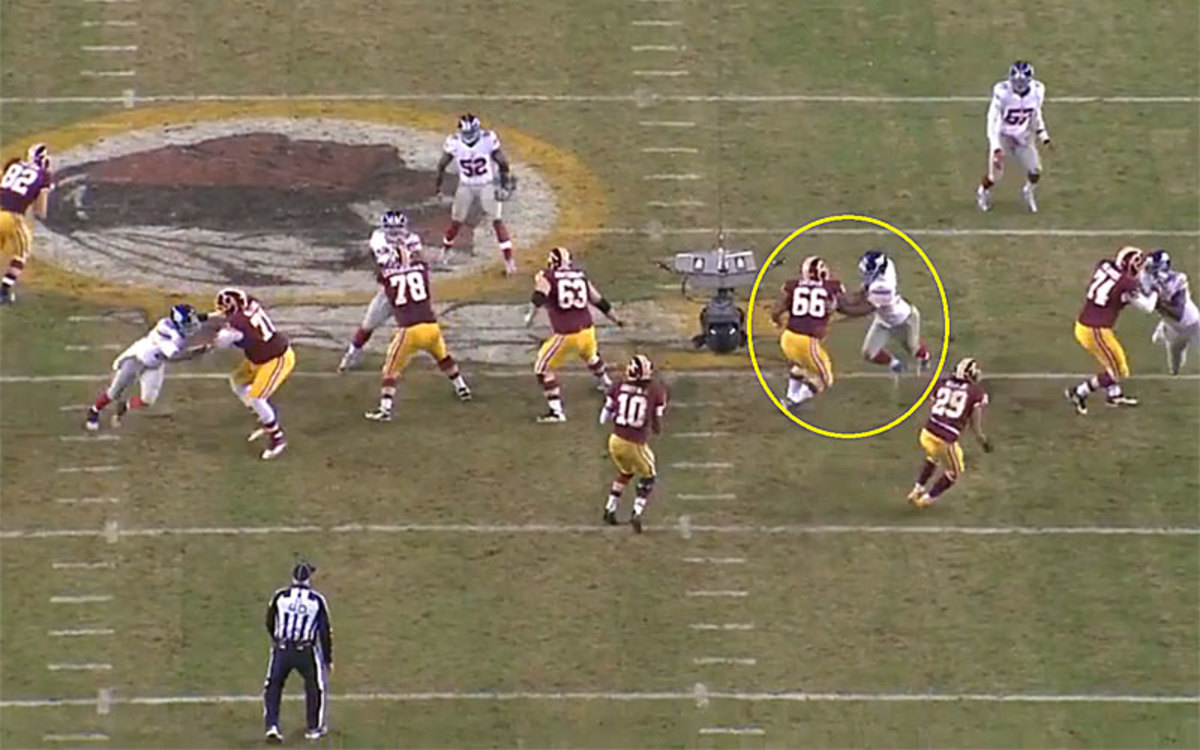
tuck1-3.jpg
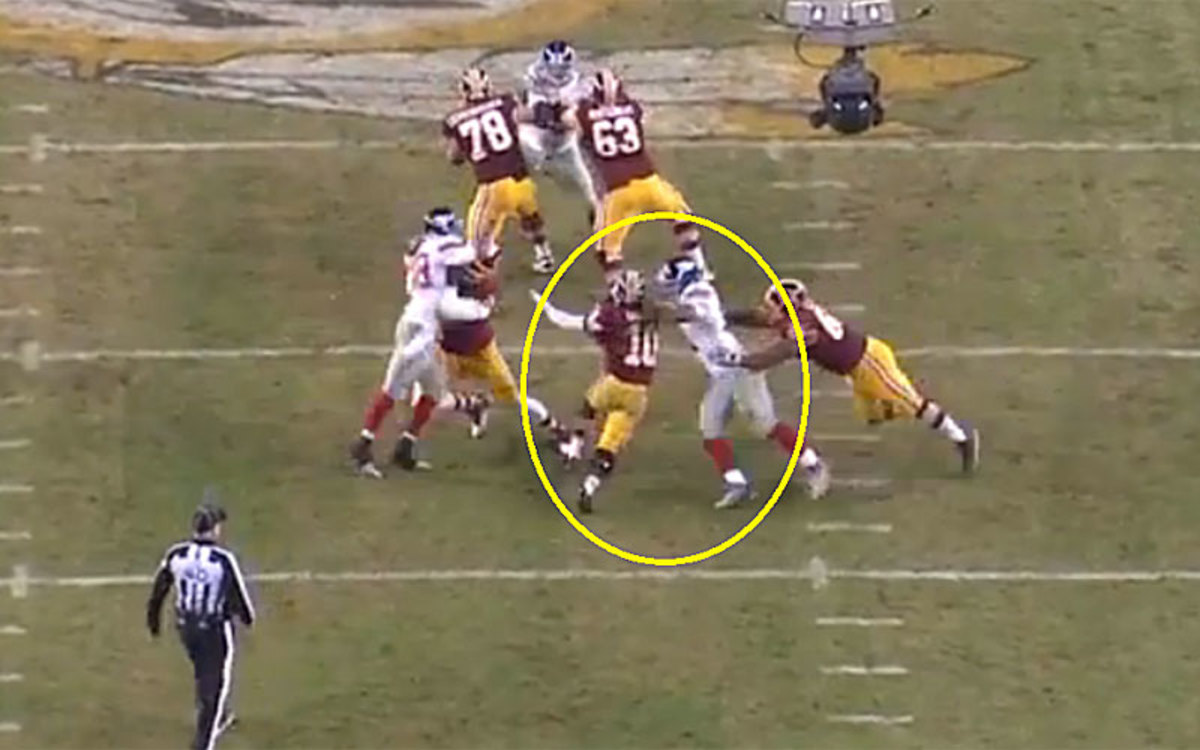
This was by far Tuck’s best sack, it was given our highest value, a 1.25 “solo sack” because Tuck defeated his block without the help of any teammate. Using a powerful swim move against Washington right guard Chris Chester, Tuck took Robert Griffin III down in just 2.52 seconds.
* * *
Pressure Points: Tuck Gets By With Help From His Friends
tuck2-1.jpg
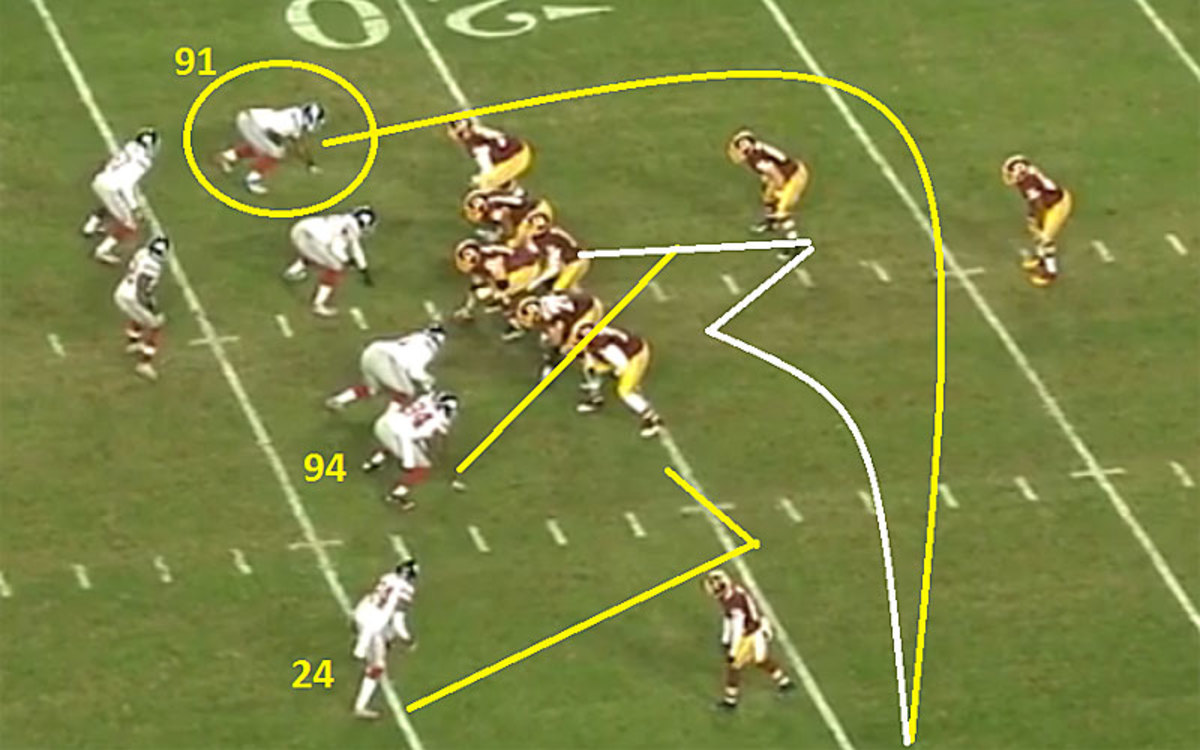
tuck2-2.jpg
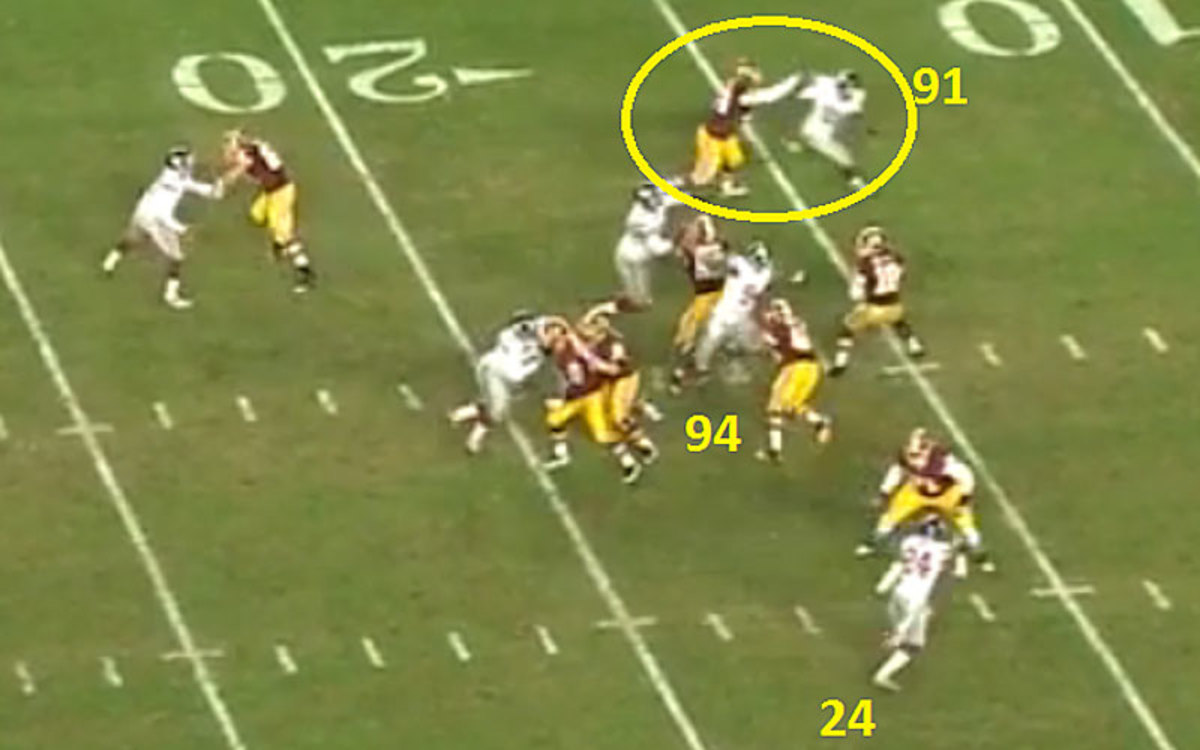
tuck2-3.jpg
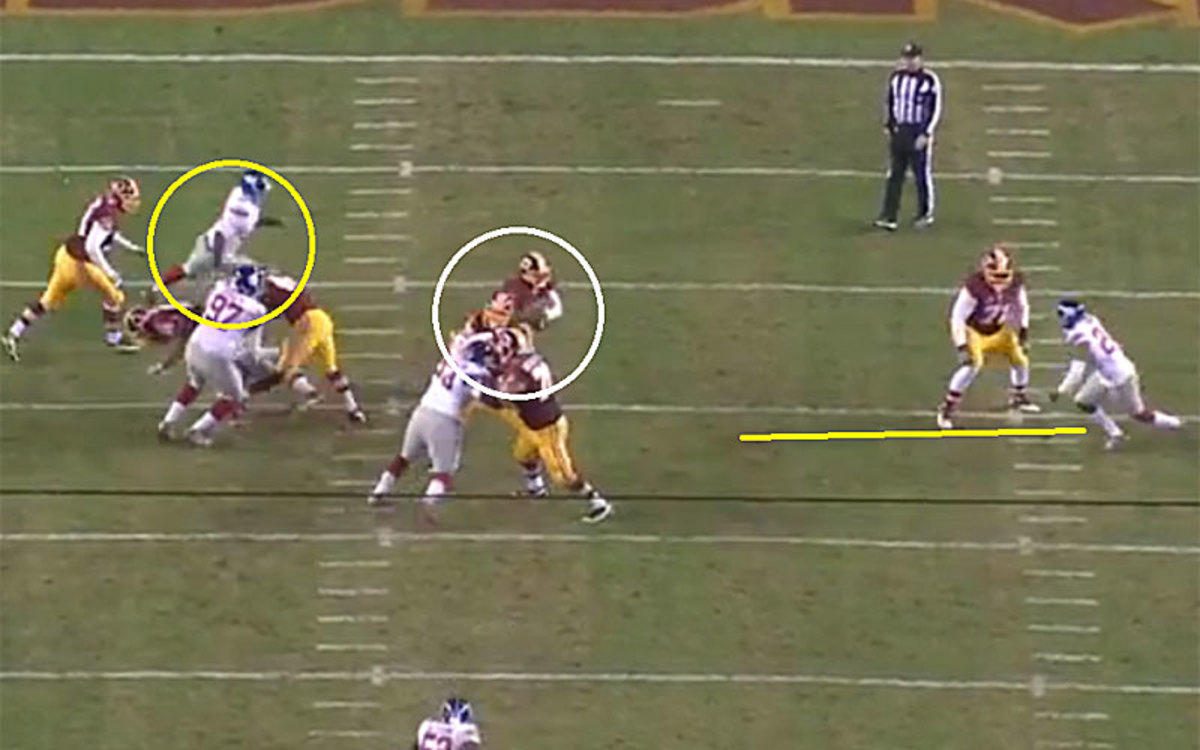
tuck2-4.jpg
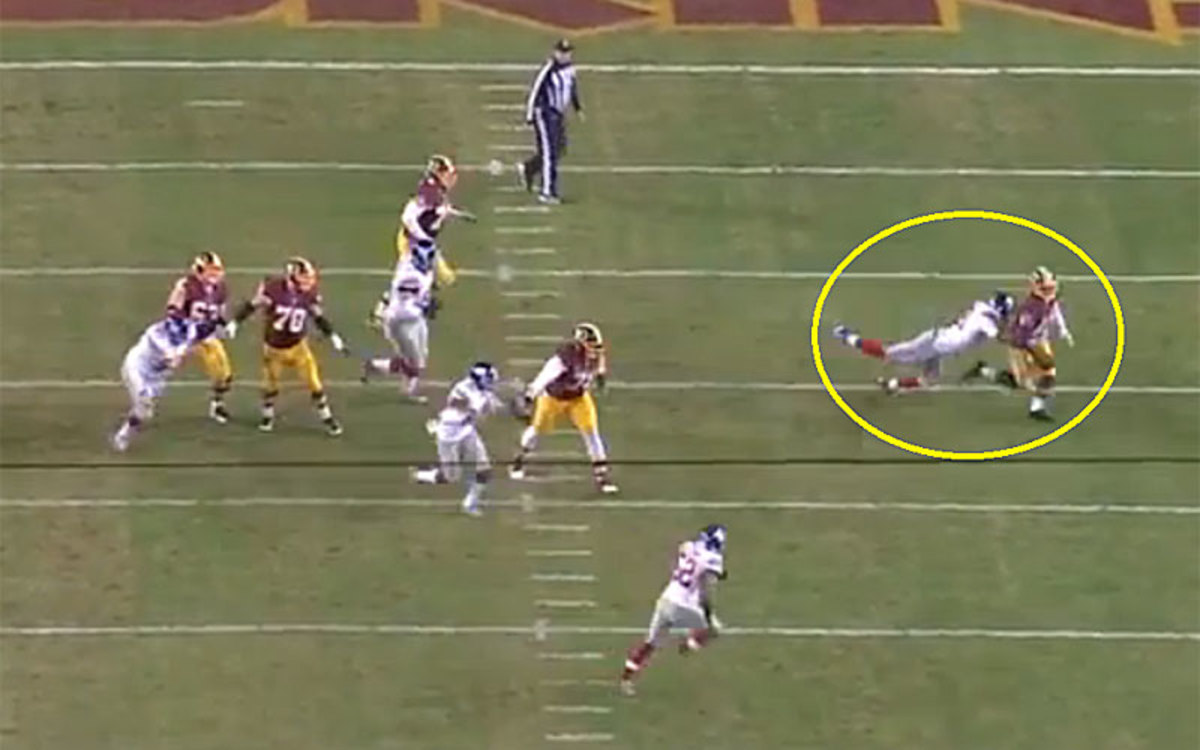
This was what we classify as an “assisted” sack (.75 points). While Tuck showed great effort staying after Griffin, the sack came after 5.08 seconds and happened because end Mathias Kiwanuka (94) first forced Griffin to scramble, and then cornerback Terrell Thomas (24) cut off Griffin’s escape route. Without Kiwanuka and Thomas on this play, there is no sack for Tuck.
* * *
Pressure Points: Tuck Gets By With Help From His Friends
tuck3-1.jpg
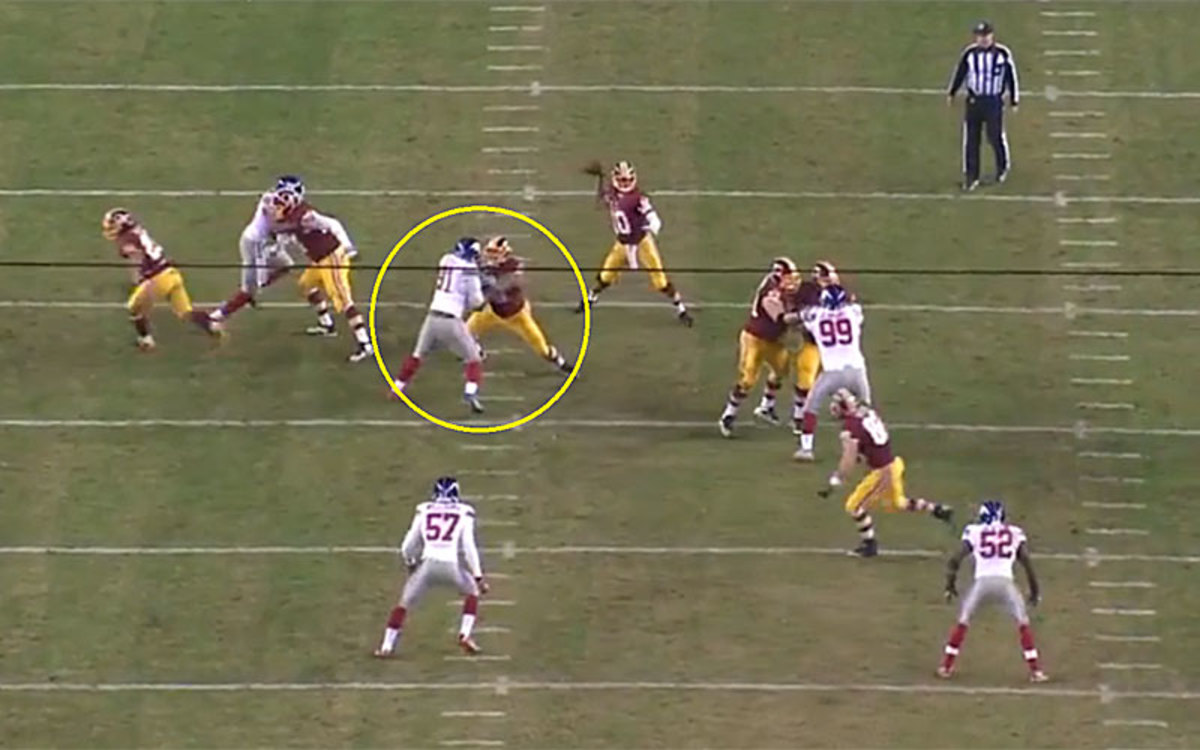
tuck3-2.jpg
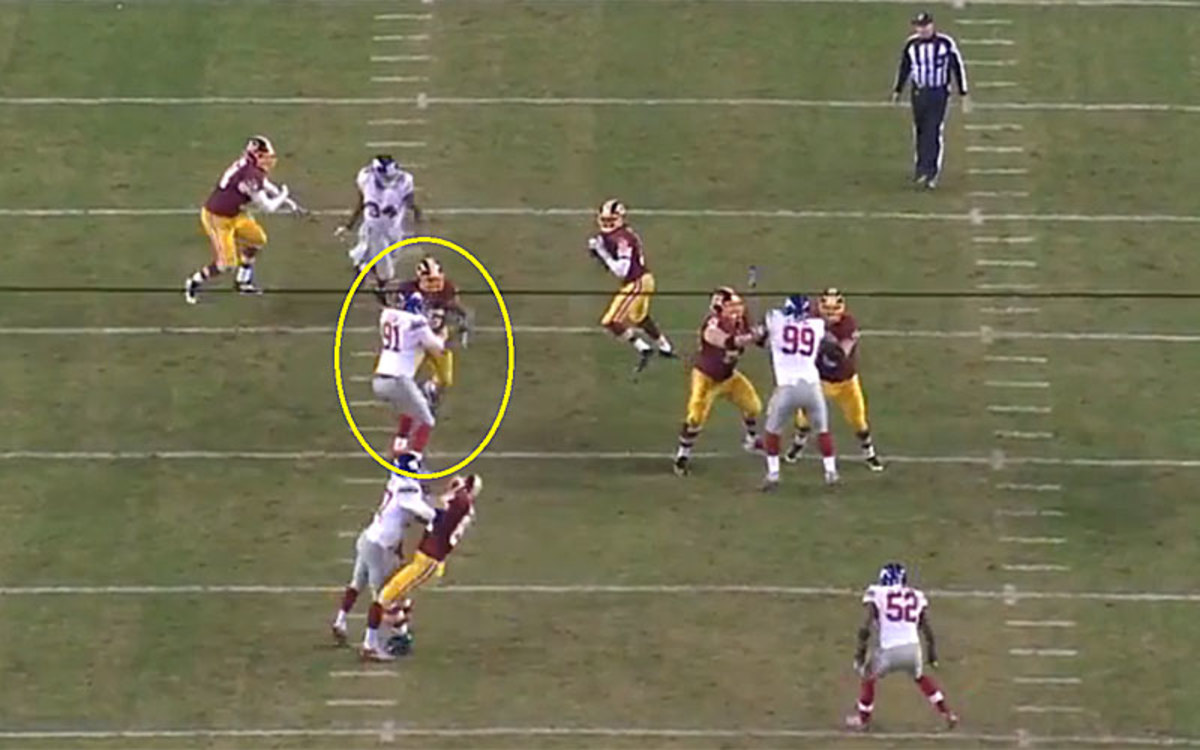
tuck3-3.jpg
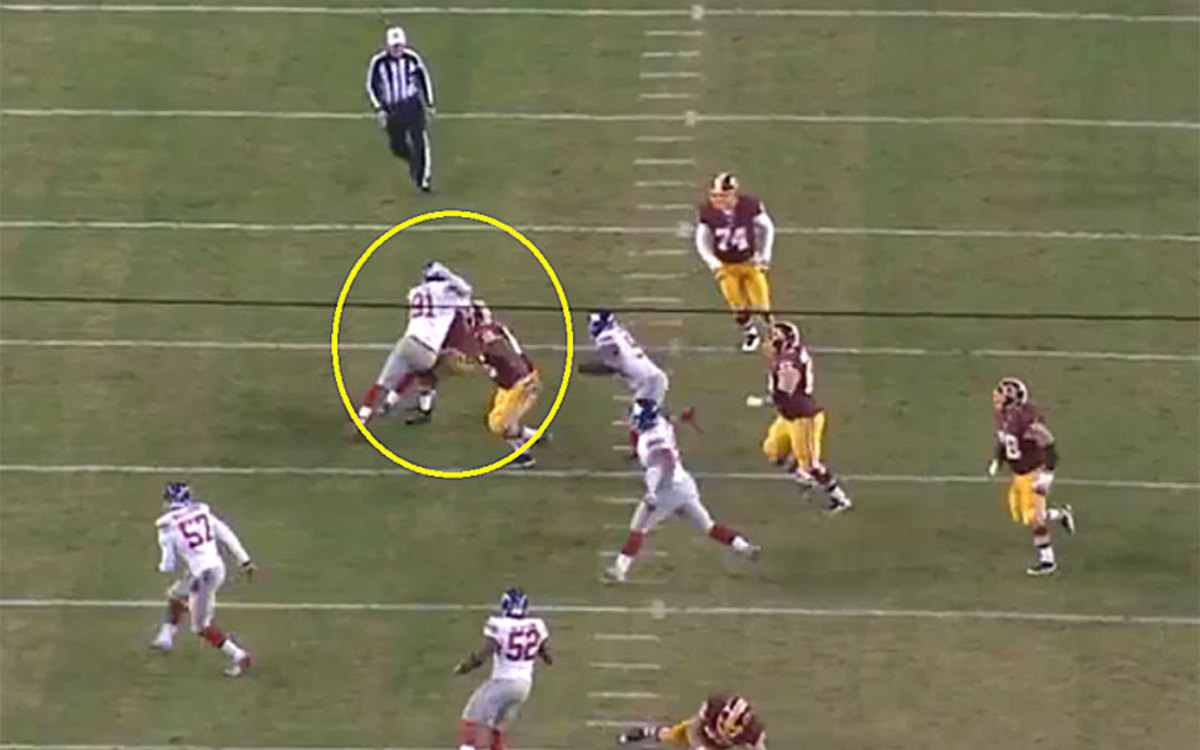
This was a gift sack for Tuck—put into our “easy” category (.75 points)—for two reasons: it was primarily a coverage sack because Griffin didn’t go down for 4.34 seconds, and because Kiwanuka’s late pressure forced Griffin into Tuck (although he still might have ended up with the sack).
* * *
Pressure Points: Tuck Gets By With Help From His Friends
tuck4-1.jpg
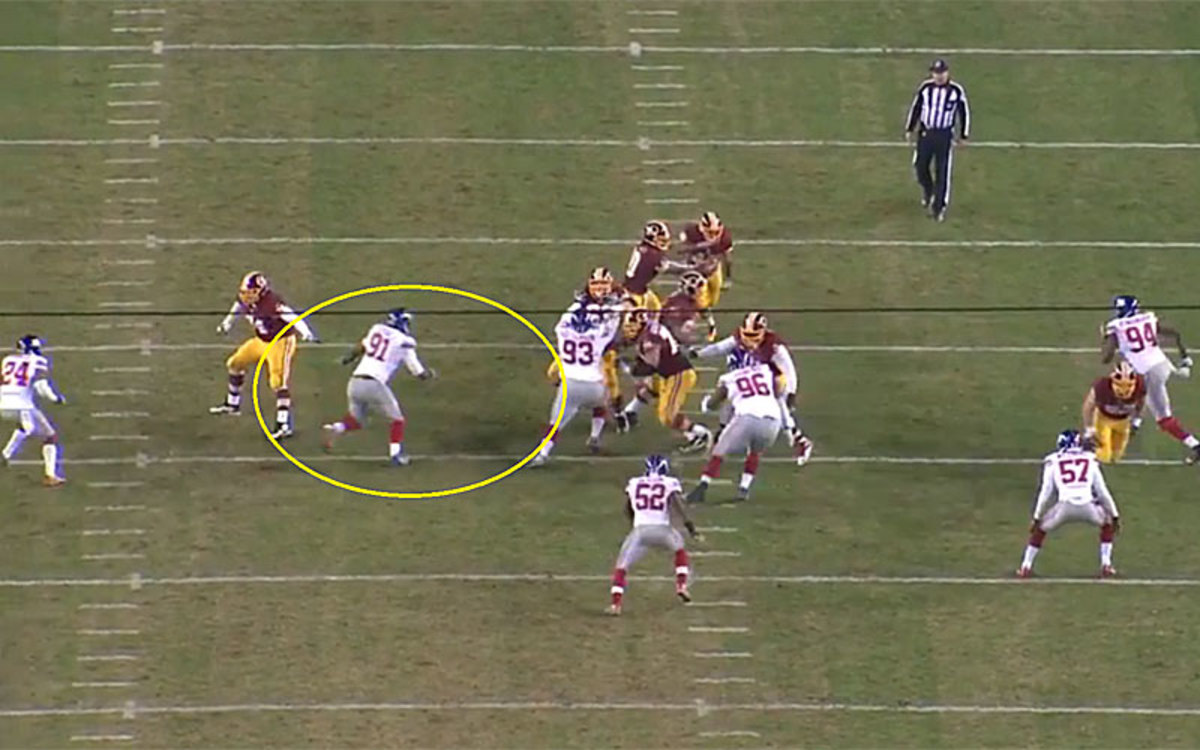
tuck4-2.jpg
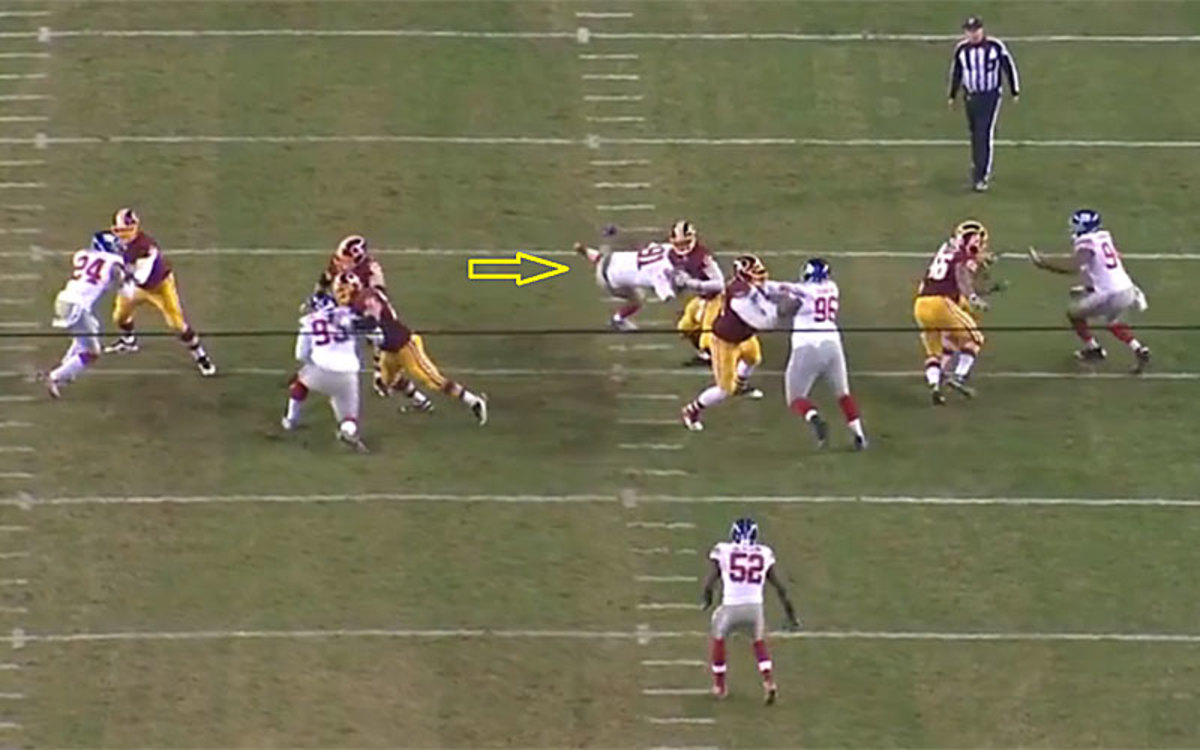
Tuck’s final sack happened because he was completely unblocked due to a screwup on Washington. Unblocked sacks are also put into our “easy” category because, well, they’re a lot easier than the sacks where a rusher wins his one-on-one battle, which is where we think ultimate credit should reside. Tuck did his job staying after Griffin and executing the tackle, but not all four-sack games are created equal. This is an example of how the Giants’ team defense should be getting the credit, not an individual because of an arbitrary statistic.
As for Tuck’s next contract, that will be determined off his performance for the season. So far, Tuck ranks 28th among edge rushers with a Pressure Rate of 7.2 (total Pressure Points divided by pass-rush snaps).
UNSUNG EDGE RUSHER OF WEEK 13
Michael Johnson, Cincinnati Bengals
After bookend tackle Carlos Dunlap took top edge rusher honors in Weeks 10 and 11, Johnson did his part by coming in tied for fourth with 3.75 Pressure Points despite not getting a sack. But Johnson did have a drawn hold and six quarterback hurries.


INTERIOR RUSHER OF WEEK 13
Kyle Williams, Buffalo Bills
Williams has been in the top 10 of our interior rushers the entire season (now sixth, right behind Ndamukong Suh of the Lions), and we discussed his pass-rush skills from the three technique when he was the unsung interior rusher in Week 9.
Against the porous Falcons offensive line, Williams had his best performance of the season with 4.75 Pressure Points: one solo sack, one sack assist, four hurries and two quarterback hits. Williams is a big reason the Bills have risen all the way to third, behind the Texans and Seahawks, in team pressure for the season.
UNSUNG INTERIOR RUSHER OF WEEK 13
Vinny Curry, Philadelphia Eagles
Curry has quietly been one of the most effective interior rushers for the season, and he stood out—despite not having a sack—against the Cardinals by finishing tied for third with 3.25 Pressure Points: one sack assist, one drawn hold, three hurries and one hit.
For the season, Curry has a total of 16.25 Pressure Points in just 160 pass rushes. If we threw out the minimum of 200 pass rushes, Curry’s rate of 10.2 would be second among interior rushers to J.J. Watt (41.2 Pressure Points in 397 rushes—10.4).


* * *



OUR METHODOLOGY
One of biggest indicators of success for NFL defensive coaches is the ability to affect the quarterback.
Sure, that means sacks, which are an official NFL statistic. And quarterback hits, which are also tallied in press boxes. But affecting the quarterback, making him feel pressure, has several other factors, most of which aren’t officially tallied (though NFL teams do them internally).
We at The MMQB thought long and hard about finding a better way to evaluate quarterback pressure, both from individual and team standpoints. We’ve developed our own formula, which we think will highlight players who aren’t getting the glory stats (sacks) but are still affecting the quarterback just as much.
The two statistics that we’ll be tabulating are sack assists and drawn holds. The latter is self-explanatory. Pass rushers are sometimes held by offensive lineman before they can sack the quarterback. Those plays aren’t official plays for the NFL. But they can be nearly as damaging. It’s a 10-yard foul, although there is no loss of down.
A sack assist is given to a player who allows a teammate to get a sack. You see it all the time. One player comes flying at a quarterback, causing him to bolt, and the QB winds up in the arms of a different defender. Sometimes the sacker didn’t do very much, yet he still gets credit for the sack. The player who actually caused the sack gets nothing. We’re going to change that.
Here’s how the formula works.
Sacks
Because not all sacks are created equally, we have divided up sacks into three categories: solo, assisted andeasy.
Solo sack (1.25 points): For the player who beats a blocker and gets the sack on his own. These are the real sack masters; they should be rewarded for their standout individual effort.
Assisted sack (.75 points): Given to the player who officially receives a sack but had help from a teammate in taking the quarterback down.
Easy sack (.75 points): An official sack that falls into one of the following categories: coverage sack (quarterback held the ball longer than 3.3 seconds because the coverage was so good); unblocked, usually because of a schemed blitz; offensive miscue, such as the quarterback tripping after getting stepped on by an offensive lineman; or garbage-time sack, which we have defined as a sack when the offense is trailing by more than two scores with four minutes or less remaining in the game.
Sack assist (.5 points): As described above, this is when a player aids in the sacking of a quarterback. The official sacker will get an “assisted” or “easy” sack (.75 points), and the disrupter gets a “sack assist.”
Disruptions
These three categories—drawn holds, hurries and hits—are not official statistics, but they’re extremely important. A team can have zero sacks, but if they accumulate hurries or hits, they’re making life extremely uncomfortable for a quarterback. The hurries and hits are shared with us by our friends at ProFootballFocus.com. Our hits and hurries include plays wiped out by penalty.
Drawn hold (.75 points): The player who draws a holding penalty on a pass play. Only tabulated if the penalty results in a “no play.” If there is holding on a sack and the sack counts, there is no drawn hold—although that player could get a sack assist.
Hurry (.5 points): When the actions of a defender causes the quarterback to alter his throw or footwork. This is what defenses call “moving a quarterback off his spot.”
Hit (.5 points): Recorded just after or as the quarterback releases a pass and goes to the ground as a result of contact with a defender.
Pressure Points
edge rushers
interior rushers
by team
